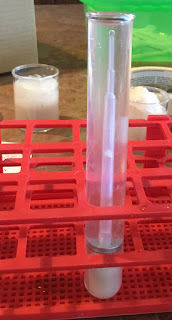We did this lab last year in my Biology class and I loved it! Of course, we did it again this year. The idea for the lab came from www.mysciencebox.org/bubblingyeast. Alas, when I tried to check the site today, the account had been suspended. The lab itself includes some links to sites that do work though.
I appreciate that this lab uses basic laboratory supplies and household items that I already had on hand. It also gives us quantifiable data, as students are busy counting the number of bubbles coming out of the pipets with the yeast. Next year we may try a different variable that the original lab suggested as extensions to the lab, such as varying the food source for the yeast.
Here are some things I was reminded about as we did the lab this morning. We have to get the yeast solution to go down into the bulb of the pipet. To do this, we held the pipet stem up and flicked the stem of the pipet to encourage the yeast down into the bulb. While I demonstrated how to get the yeast down into the bulb, I forgot to cover the tip of the stem. As yeast solution sprayed all over me, I quickly remembered that I needed to cover the tip with a paper towel. We put several drops of bromothymol blue to test for the presence of carbon dioxide. As you can see in the pictures, the pipets of yeast in warm and room temperature water, quickly turned from blue to yellow. I also had no success getting my kidney beans to germinate. They mainly got moldy and stinky. I'll go back to black beans next time. Last year, even the beans had a noticeable color change in the bromothymol blue. We do beans along side the yeast to help students understand that plants go through respiration as well (and thus produce carbon dioxide).
Here is the teacher information sheet that the website gave and here is the lab I put together from the information from the website.




No comments:
Post a Comment